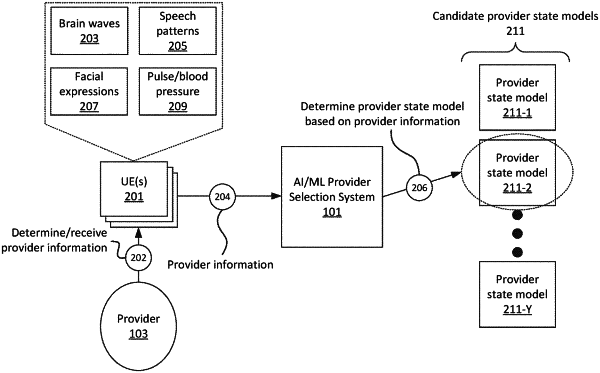| CPC G06Q 10/063112 (2013.01) [A61B 5/02 (2013.01); G06Q 10/063114 (2013.01); G06V 40/176 (2022.01); G06V 40/20 (2022.01)] | 20 Claims |

|
1. A device, comprising:
one or more processors configured to:
maintain a first set of artificial intelligence/machine learning (“AI/ML”) models that correlate respective sets of brain wave information to respective provider states;
measure brain wave information associated with a plurality of service providers via one or more Electroencephalography (“EEG”) devices;
determine a particular provider state associated with each respective service provider, of the plurality of service providers, based on the measured brain wave information associated with each respective service provider, wherein determining the provider state for each service provider includes:
comparing the measured brain wave information, associated with each service provider, to the first set of AI/ML models,
identifying, for each service provider and based on the comparing, a respective AI/ML model that corresponds to the respective brain wave information associated with the each service provider, and
identifying a particular provider state, for each service provider, based on the identified AI/ML model for the each service provider;
maintain a plurality of service queues that are each associated with a respective type of service request;
maintain a second set of AI/ML models that correlate respective provider states to respective service queues of the plurality of service queues;
assign particular service providers to respective service queues, of the plurality of service queues, based on comparing respective provider states of the plurality of providers to the second set of AI/ML models;
receive an indication of a service request;
identify a particular type of the service request;
select, based on the determined provider states, a particular service provider, of the plurality of service providers, to respond to the service request, wherein selecting the particular service provider includes:
selecting a particular service queue, out of the plurality of service queues, that are associated with the particular type of the service request, and
selecting the particular service provider from the service providers assigned to the particular service queue; and
respond to the service request by providing an indication of the selected particular service provider.
|